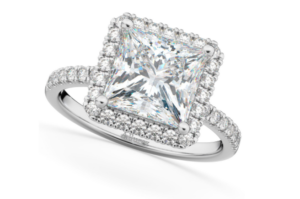
The Different Types of Moissanite And Which Is Best For You
Many people turn to moissanite as a more affordable option to diamonds, but others don’t even know what it is. For that reason we’re here to example what mossanite is exactly, the different types and why it may be the best option for you or your loved one.
What is moissanite?
Moissanite was discovered in 1893, in a crater created by a meteorite that fell to Earth, by French Nobel Prize-winning scientist Henri Moissan. It was found at the site of a massive meteorite strike in Arizona. Moissan initially thought he discovered diamonds, but later determined that the crystals were composed of silicon carbide. The gem was eventually named after him.
In 1958, moissanite was found in the Green River Formation in Wyoming and, the following year as inclusions in kimberlite from a diamond mine in Yakutia. There are very small quantities of natural moissanite left on earth so nowadays it’s almost always lab-grown, and for a fraction of the cost of even lab-made diamonds. Moissanite was introduced to the jewelry market in 1998 after the firm Charles & Colvard received patents to create and market these lab-grown gemstones, making them the first company to do so.
Moissanite is engineered to give the illusion of similarity to diamonds, and with the naked eye it could pass as a diamond, but is compositionally different from a diamond. The durability, brilliance, and color of the two gems are quite distinct. According to an article in Money magazine, “while a perfect, colorless two-carat diamond will cost you upwards of $40,000—and an imperfect one-carat diamond can still set you back nearly $10,000—a nearly flawless one-carat moissanite gem costs less than $1,000. And thanks to recent innovations in the way they are made, moissanite stones are tough to distinguish from natural diamonds, even for experts.” Moissanite engagement rings offer you the hardiness of a diamond, without taking the small toll on your wallet.
Moissanites come in all of the same cuts, settings, and configurations in which diamonds can be made. Moissanite jewelry includes rings, earrings, necklaces and pendants.
At 9.25 on the Mohs scale, moissanites are close behind diamonds (which is 10 on the scale) as the second hardest mineral in the world. Moissanite also has a higher brilliance and fire (meaning sparkle and light- dispersion) than a diamond.
While moissanites are labeled as “colorless,” they can project a yellow or grayish hue in certain lights. Similar with diamonds, the larger the moissanite, the more noticeable the color. The smaller the moissanite, the more colorless it will look.
Moissanites look beautiful when set in rings featuring diamond accents.
What are the different moissanite types?
Allurez offers four types of moissanite:
Forever one colorless: The premium brand of moissanite. These gems fall within the range of internally flawless to very slightly included (IF-VS).
Forever one near-colorless: Also a premium brand of moissanite. Flawless with some color.
Pure light: Intensely white colorless gem that is graded as D, E or F in color.
True light: True light shows a distinct hearts and arrows pattern and has Very Good+ to Excellent light behavior rating.
Why choose a moissanite over a diamond?
1) Affordability: Moissanite is up to 90 percent cheaper than a diamond of the same type of appearance. It’s affordable pricing is one of its most appealing qualities. For example, a 1 carat diamond costing $4,000 would be $400 for a 1 carat moissanite. While a diamond’s price varies based on cut, clarity, and other aspects, moissanite stones are usually the same price and vary only with size and type of moissanite (enhanced or non-enhanced). Also like we said before, moissanite has a higher brilliance than a diamond, meaning they give off more of a sparkle (and who doesn’t love a good sparkle). Moissanite is also less expensive per carat than many other gemstones.
2) Be different: Most people have diamond engagement rings, making them traditional and expected. But moissanite came from the stars (literally!) so having a moissanite ring will make your bling different from everyone else’s. Step outside of the box!
3) It’s eco-friendly: Moissanite is created in the lab, with minimal environmental impact. Because they’re lab-grown, they are a great option if you’re seeking an eco-conscious gemstone, since no mining is done in the creation process. It’s not harmful to the earth and it is not involved in any conflict trade.
4) Durability: Moissanite is a 9.25 on the Mohs Scale of Hardness, so it is suitable for everyday wear and great for an engagement ring. In terms of getting scratches, the harder the stone, the hardest it is to scratch it.







POST COMMENT